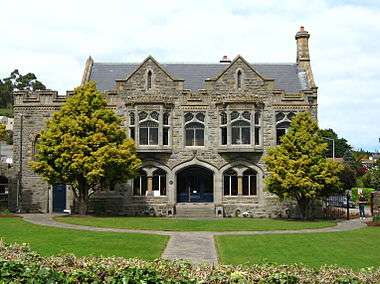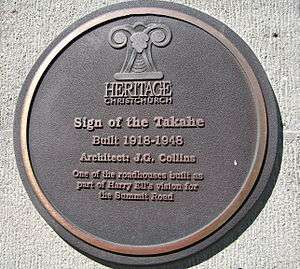Sign of the Takahe


The Sign of the Takahe is today a restaurant and function centre built in the style of an English Manor House. Designed by J. G. Collins, construction was carried out between 1918 and 1948. The Takahe also provides one of the better panoramic views of the city of Christchurch, New Zealand, the Canterbury Plains and the Southern Alps.
Named after the flightless native New Zealand bird, the Takahe, it was initially one of the roadhouses planned by Henry George (Harry) Ell as part of his scheme to preserve the natural state of the Port Hills which overlook Christchurch and Lyttelton harbour.
Ell had envisaged four roadhouses being built, and three were completed before Ell's death in 1934. These were Sign of the Kiwi, Sign of the Bellbird and Sign of the Packhorse.
However, Ell wished the Takahe to be a more substantial structure and spent years studying design of English Manors, castles and inns, to be incorporated into the final construction of the Takahe. Indeed, the dining room is an exact replica in the historic Haddon Hall in Derbyshire.
A great deal of improvisation was required to minimize cost. For example, the stone was quarried locally from the Port Hills and hand chiseled into blocks using primitive tools, the heavy Kauri beams in the entrance hall were salvaged from a former bridge over the Hurunui River and the ceilings in the inner most dining room were painted on timber cut from packing cases.
The building has a Category I listing with Heritage New Zealand.[1]
References
- ↑ "Sign of the Takahe". Register of Historic Places. Heritage New Zealand. Retrieved 2010-03-09.
- Harry Ell and His Summit Road : a Biography of Henry George Ell by Lenore Oakley, published by Caxton Press 1960
External links
Coordinates: 43°34′53.6″S 172°38′7.2″E / 43.581556°S 172.635333°E